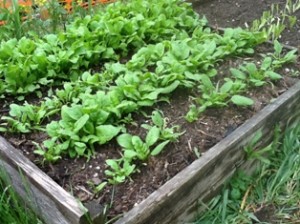We’d like to share some gardening tips, since spring is here and flowers are blooming, which makes it the perfect time to dig into some gardening. According to the National Gardening Association, over 78 million Americans love gardening—and for good reason! It is calming, therapeutic, and a great way to spend time outdoors in a world that is increasingly indoors. As people age they may find gardening becomes difficult, but here are several gardening tips to keep this activity easier and enjoyable at any age.
Here are some recommended gardening tips from the Agricultural Engineering Extension:
- Paint your garden tools in different bright colors so they are easier to pick out, and easier to find when they’re dropped in the grass or laid down while weeding.
- Use a vertical garden or trellis to avoid a lot of bending over and stooping down. This works great for vining plants like cucumbers, reduces mildew and increases yield.
- Bring a stool or chair to avoid constant squatting. There are several on the market with big wheels for easy movement.
- Don’t garden during prime sunlight hours (between 10am and 2pm) because you are more likely to get sunburned or heat illness during these times. It’s also the time when your plants are most likely to be conserving energy by wilting on hot days.
- Drink plenty of water and other caffeine free liquids to stay hydrated while working in the sun. You need as much water as your plants do!
- Wear lightweight, long-sleeved clothing, a hat, sunglasses and gardening gloves. Don’t forget the sunscreen. In Maine, pay special attention to checking for ticks regularly. If you use a tick spray, use it on your boots and socks, or pants tucked in to socks. Don’t spray it on your skin.
Gardening Tips for Seniors
 A great way to garden is with raised beds. For seniors, they have the added benefit of being higher than a regular garden so they are easier to sit in front of, especially to avoid straining the back. Raised beds are helpful in general because they make much more organized gardens. They can be separated into several square beds, so you can walk between them without stepping on a garden and easily reach all sides of it, which also keeps the pathways between beds dry and clean.
A great way to garden is with raised beds. For seniors, they have the added benefit of being higher than a regular garden so they are easier to sit in front of, especially to avoid straining the back. Raised beds are helpful in general because they make much more organized gardens. They can be separated into several square beds, so you can walk between them without stepping on a garden and easily reach all sides of it, which also keeps the pathways between beds dry and clean.
Gardening tips from experience: Make sure you plan the spacing so that the lawn mower fits in between the raised beds and can make it around the corners.
Raised beds are a huge space saver as well, and a garden design can even be made in advance to help with seasonal planning. They are neat and tidy so it’s easy to rotate your plants, which keeps soil healthy and nutrient-rich. The wooden sides make it easy to mow and weed whip around the bed. It’s not walked on so the soil stays nice and loose for breathing, and after the first year or two weeds almost disappear. It’s the perfect easy garden and the sun is out—so go for it!
Gardening tips include table beds
Another form of raised bed is the kind that’s literally at hip level. Beds are created on carts or islands, often with plastic liners. They’re especially good for wheelchair gardeners. While not well suited for potataoes or corn, these type of raised beds are great for patio tomatoes, herbs and almost any flower. Annuals don’t have the root system that support perennials, and grow well in these sort of raised beds.
Make sure the plastic liners have drainage holes so that you’re not gardening in a bath tub. All the lettuce family love table gardens!
Gardening tips was written by Taryn Yudaken, a Portland based freelance writer specializing in health and food writing. Reach her at Taryn.yudaken@hotmail.com
Madigan, Carleen. The Backyard Homestead. North Adams, MA: Storey Pub., 2009. Print.
“Tips and Techniques for the Senior Gardener.” Missouri AgrAbility Project. N.p., n.d. Web. 10 May 2013.